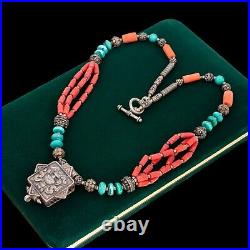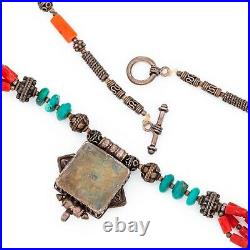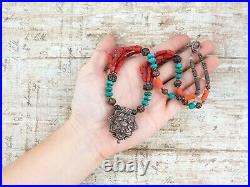Antique Vintage Deco Sterling Silver Chinese Turquoise Prayer Box Necklace 55.6g




We have similar Chinese and Art Deco items, which would pair nicely with this piece, for sale this week. Listing Description by: Angela A. Age Circa : Art Deco C. Markings : “925” on the back of the prayer box, tested, and guaranteed. Country of Origin : China. Gram Weight : 55.6 grams. Main Stone : Chinese Turquoise. Diameter: 6.33 mm to 8.21 mm. Depth : 3.40 mm to 4.65 mm. Color: opaque blue hue with mottled lighter blue hues and a black matrix. Accent Stone : Red coral. Length: 6.57 mm to 11.85 mm. Width: 3.48 mm to 6.81 mm. Color: slightly semi-translucent red-orange hue. The stone(s) appear to be untreated, but we are not certified gemologists. Stone(s) have been tested and guaranteed using a professional Presidium Duo refractive, heat, and hardness tester. Stone Cuts : Carved and polished turquoise and red coral beads. Wearable length: 18.88. Chain width: 3.99 mm to 9.97 mm. Pendant measurements: 1.46″ long by 1.27″ wide. Closure/Clasp Type: Toggle clasp. Link Type: Sterling silver, turquoise, and red coral beads on wire. Handmade during the Art Deco era in Tibet. Chinese & Tibetan export jewelry was very fashionable during this time period, with necklaces such as this highly sought after by socialites and aristocrats in North American and Europe. Also created in the Byzantine Bali style. Round and disk-shaped turquoise beads adorn the wire between elongated, carved red coral beads. Sterling silver beads with wire twist and granulated bead designs also were strung on the wire in Byzantine Bali style. A pendant with a repousse design rests at the lower center of the necklace. The back of this prayer box pendant opens at the back to reveal a small compartment, traditionally used to hold written prayers. Completed with a toggle clasp for secure wear. Damage: Age appropriate wear. There is naturally pitting to the faces of some of the coral beads; this does not affect wear. There is tarnish on the sterling silver, as well as minor dents on the back of the prayer box, which does not affect wear. The price has been reduced to reflect this. This listing is for the item only. The Art Deco era is famous for being the “Gatsby” or “Roaring Twenties” era. A lot of gorgeous and timeless designs in jewelry came out of this period. Jewelry from this period was most often crafted between 1920 and 1940. Art Deco jewelry sometimes featured white gold or platinum, geometric designs, European cut diamonds, filigree, and calibre cut stones that are specially cut to fit the design of the piece. During the Art Deco period jewelers often made jewelry upon custom order, this would usually take weeks to months to completely craft by hand. Chinese export jewelry became popular during the late Victorian period and persisted until the 1960s. During this period, Chinese craftsmen were considered by far the best in the world. The rich and wealthy would custom-order a piece through their local jeweler, who would send the design off to China to be made and sent back to Europe. This lengthy process was very expensive, making Chinese export pieces highly desirable, then and now. Byzantine Bali jewelry was crafted with a classic twisted or braided style that invokes a sense of the ancient times of the Byzantine Empire, where men and women wore jewelry as a symbol of status and power. Interwoven links, rope twist details, and looping applied wires, and granulated beads are the hallmarks of this bold style of jewelry. Chinese turquoise is considered a very valuable stone by the Chinese, second only to jade. In fact, Chinese Turquoise was often used to supplement or replace jade. Chinese turquoise was highly prized for its rarity and gorgeous, bright blue hues. Stones that exhibit a spiderweb matrix are quite rare and deeply coveted. Red coral has played an important part in Chinese art, culture, and style throughout history and into the 21st century. Red coral has been used as an ornamental stone or material in Chinese jewelry, carvings, and sculptures because of its vibrant variety of red hues. In ancient times, red coral was delivered to China by the Silk Roads from Italy, by sea from the Persian Gulf, and from the Mediterranean Sea via the Indian Ocean. The amount of natural red color has dramatically decreased in recent years due to environmental factors and coral harvesting. The quantity of manufactured coral on the market has increased as the popularity of Chinese red coral continues. Prayer boxes come in many shapes, sizes, and materials, and are used by many different faiths, including Buddhism, Hinduism, Islam, Christianity, and Judaism. These faiths would encourage practitioners to write down prayers or religious musings on a small piece of paper and put it inside the prayer box. If the prayer box was small enough, it could be incorporated into jewelry, so the prayers could be carried everywhere with the wearer. Repoussé began as an ancient metalworking technique dating as far back as the 3rd century BC, involving malleable metal that was hammered onto the reverse side to create an image on the front. Examples are found all over the world; Greece, Egypt, and even the Hopewell periods in the American southeast. Reverse side hammering was also used to add detail to the front, creating intricate patterns using grooves, indentations, and channeling. The piece was then carefully polished to create a hollow, eye-catching treasure. The item “Antique Vintage Deco Sterling Silver Chinese Turquoise Prayer Box Necklace 55.6g” is in sale since Sunday, March 14, 2021. This item is in the category “Jewelry & Watches\Vintage & Antique Jewelry\Fine\Art Nouveau/Art Deco 1895-1935\Necklaces & Pendants”. The seller is “abeautifultimeco” and is located in Fort Collins, Colorado. This item can be shipped worldwide.
- Modified Item: No
- Country/Region of Manufacture: China
- Style: Chain
- Ethnic Origin: Tibetan
- Accent Stone: Red Coral
- Metal Purity: .925
- Main Stone: Turquoise
- Metal: Sterling Silver

